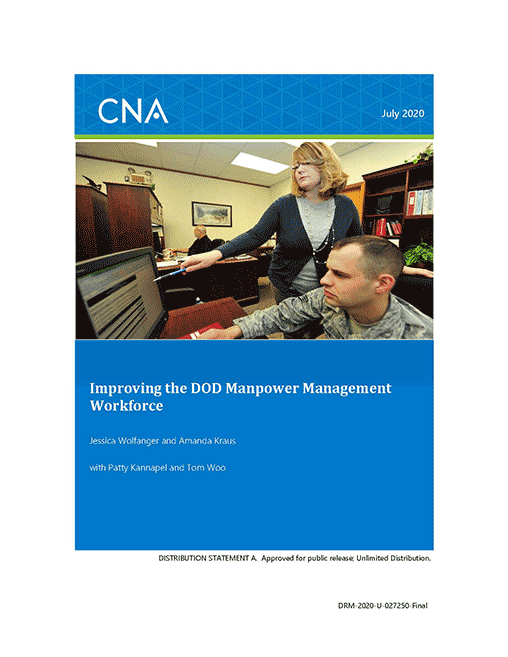The manpower management (MM) process in the Department of Defense (DOD) determines the quantity and mix of Total Force labor necessary for a given activity. It ensures that there are enough people with the right capabilities to achieve the mission, while considering which type of labor is the most cost effective. This process for determining, assessing, and validating requirements, associated manpower, and the workforce mix necessary to achieve an organization’s mission is complex and requires specialized knowledge, skills, abilities (KSAs) and experience. Unlike other career fields, however, there currently is no common training or certification process that ensures minimum standards and competencies among those performing MM functions: each component handles the personnel performing MM functions differently. This project examines whether common training and standards for all personnel performing MM functions in DOD is achievable and desirable.
Combining information collected from past studies and policy documents, subject matter expert (SME) discussions with manpower experts throughout DOD, and position data analysis, we explore who is performing MM in DOD, how they are trained, and the KSAs necessary to perform MM functions. We then explore whether there is sufficient overlap of MM functions and KSAs across organizations and types of personnel to standardize MM training and education. Finally, we answer the question of whether MM training should be standardized. This assessment takes into account evidence from previous assessments of the quality of the MM workforce and how it affects MM processes and outcomes, SMEs’ appetite for standardization, and lessons learned from implementing the Defense Acquisition Workforce Improvement Act (DAWIA).
Although we find evidence that there are MM training inefficiencies and gaps in DOD and that, in general, MM policies, functions, and KSAs are similar enough to allow standardized training and education, we find that DOD does not have the data necessary to show that improving the quality of MM workforces will improve MM processes and outcomes. First, the MM workforce acts within the confines of the MM process. If the process itself is not operating effectively as has been shown in previous studies, workforce improvements will have a limited impact. In addition, to identify the effect of workforce quality on MM outcomes, DOD needs to assess MM outcomes and relate those outcomes to the workforce. Currently, such a mapping of the MM workforce to outcomes is not possible. Accomplishing this would require the development of metrics that inform the quality of the work being done.
We recommend that DOD collect the data necessary to continue analysis of whether a DOD- wide MM training and education program is desirable. This includes performing a manpower requirements determination (MRD) study of the DOD MM workforce to understand the true requirement for MM throughout DOD. We also recommend that DOD conduct a full competency assessment to obtain detailed information on the KSAs required for the various MM functions.
Finally, we recommend that DOD define MM outcomes and develop metrics based on the things that the MM workforce could influence and that ultimately would affect outcomes. Without a definition of outcomes that the MM workforce could be expected to influence, and a way to measure those outcomes, DOD cannot use outcomes to measure the MM workforce’s quality.
Download reportDISTRIBUTION STATEMENT A. Approved for public release; Unlimited Distribution.
Details
- Pages: 90
- Document Number: DRM-2020-U-027250-Final
- Publication Date: 7/14/2020
